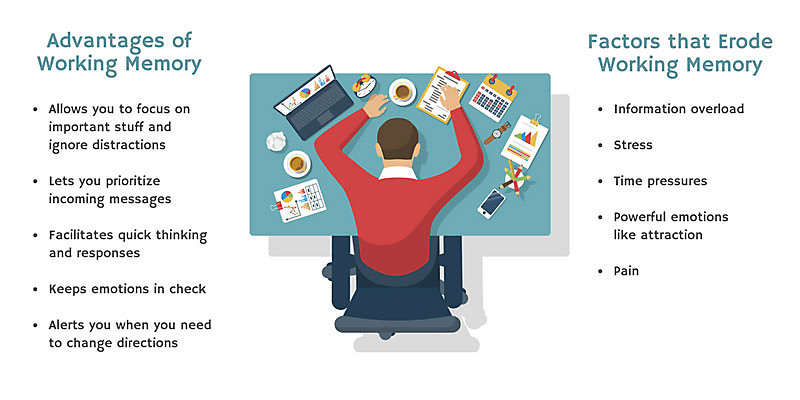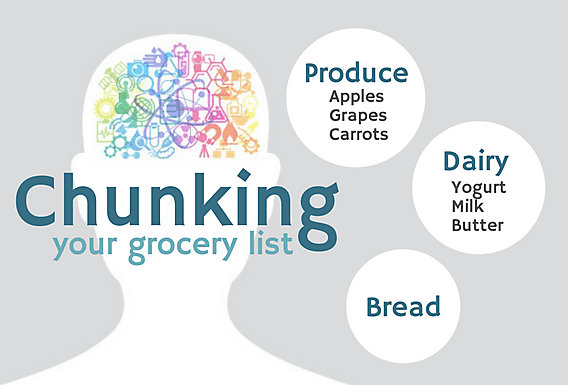Every moment of our waking day is filled with comprehension, reasoning and decision making processes that are both simple and complex. Though we may not know exactly how our brain seamlessly completes these tasks, it's largely our working memory that manages information necessary to plan and carry out desired behaviors.
Working memory plays an important role in many beneficial behaviors. It helps us make sound decisions, stay positive, learn and stay motivated to complete daily tasks.
How Working Memory Works
Working memory is one of several types of memory, including long-term and short-term memory. 1
One type of long-term memory, called episodic memory, can be best described as our file cabinet of life’s events and acquired knowledge. Each of us has our own unique rich history of long-term memories that characterizes our past.
Short-term memory is more temporary. It can be described as our brain’s notepad, helping us keep information accessible. For instance, short-term memory helps us recall a person’s name, their company and job role at a networking meeting.
Experts say our working memory is not entirely separate from short-term memory. Working memory allows us to use short-term information rather than just recall it. At the networking meeting mentioned above, working memory allows you to quickly recall that a friend is interviewing for a new job at the very same company of the person you just met, and you make a note on the back of the person’s business card to introduce them later by email. Your working memory helped you access the information about your friend’s job search, apply it to the new information and put it to good use. When a task is complete, our brain files that information into our long-term memory to remember it for later use.

The Conductor of the Brain
Authors and working memory researchers Tracy and Ross Alloway, PhDs, refer to working memory as the “conscious processing of information.” 2 They call working memory your brain’s conductor of your daily symphony of information. Without a process to keep order among the onslaught of information – emails, phone calls, social media, to do lists, family responsibility and co-workers demands – our day would be chaos, much like a symphony with no leader.
The Alloway’s note that the working memory conductor has two primary functions: 2
- Prioritize and process information, allowing you to ignore what is irrelevant and work with what's important.
- Hold on to information so you can work with it.
In their book, The Working Memory Advantage (2013), they say that a healthy working memory plays a pivotal role in many areas of our lives, including our success at work, our relationships, mood and even our food choices.
Other examples of working memory: 2
- Remembering instructions given to you by the doctor at an appointment and repeating them back to someone or following them out.
- Focusing on what's important, despite disruptions and anxiety. For example, despite a hectic home life with young children, you are able address their needs, while preparing for an important presentation at work.
- Making a recipe and keeping all the steps in mind while your kids ask when dinner will be ready. The amount of times you must look back at the recipe is an indication of how well your working memory is functioning.
How Can We Improve Working Memory?
Questions remain as to how working memory can be improved, particularly as one ages. Ongoing studies show that working-memory functioning changes across one’s lifetime and may be modified by training. 4
Early studies show that the capacity for working memory is limited and may only hold a small amount of information, however capacity can be increased through “chunking” bits of information into groups. Most recently, researchers have begun looking at brain exercises to improve working memory. There's also evidence to show that what we consume in foods and bioactivies may play a role in how our working memory functions. 5,6,7,8
Look for more information in future posts on the science behind Neumentix, a dietary supplement ingredient that supports working memory.

References:
- Cowan N. What are the differences between long-term, short-term, and working memory? Progress in brain research. 2008;169:323-338. doi:10.1016/S0079-6123(07)00020-9.
- Alloway, Tracy and Ross, PhDs, The Working Memory Advantage, Simon & Schuster, New York, 2013.
- Baddeley, A. (1992). Working memory. Science, 255(5044), 556.
- Klingberg T. Training and plasticity of working memory. Trends Cogn. Sci. 2010;14:317–324.
- Fonseca, B. et al. Effects of a distinct phenolic complex on working memory performance in healthy men and women with age-associated memory impairment. [Abstract] American Academy of Neurology Conference, Washington D.C., 2015.

Tips for Staying Trim this Winter

The Control You've Been Craving

Five Factors that Affect the Immune System

The Mind-Body Connection
Browse Latest Articles by Topic
- Key Insights from Vitafoods Europe 2025: Innovations Driving the Next Era of Nutrition
- Support Eye-Brain Health in a Screen-Filled World with Nutritional Carotenoids
- Strengthen Children’s Natural Defenses Through Gut-Immune Health
- Supporting Maternal Health with Lutein: Essential Nutrients for Moms and Babies
- Digestive Health Strategies to Support the Body & Its Natural Defenses
- Understanding Digestive Stressors and the Body’s Natural Defenses
- Celebrating Women in Science at Kemin
- Partnering with Purpose: How Kemin Supports Nutraceutical Manufacturers from Formulation to Market
- Top Supplement Trends for 2025: A Look at the Future of Health and Wellness
- Nourishing the Mind and Sight: Shifting perspectives in NeuroNutrition
